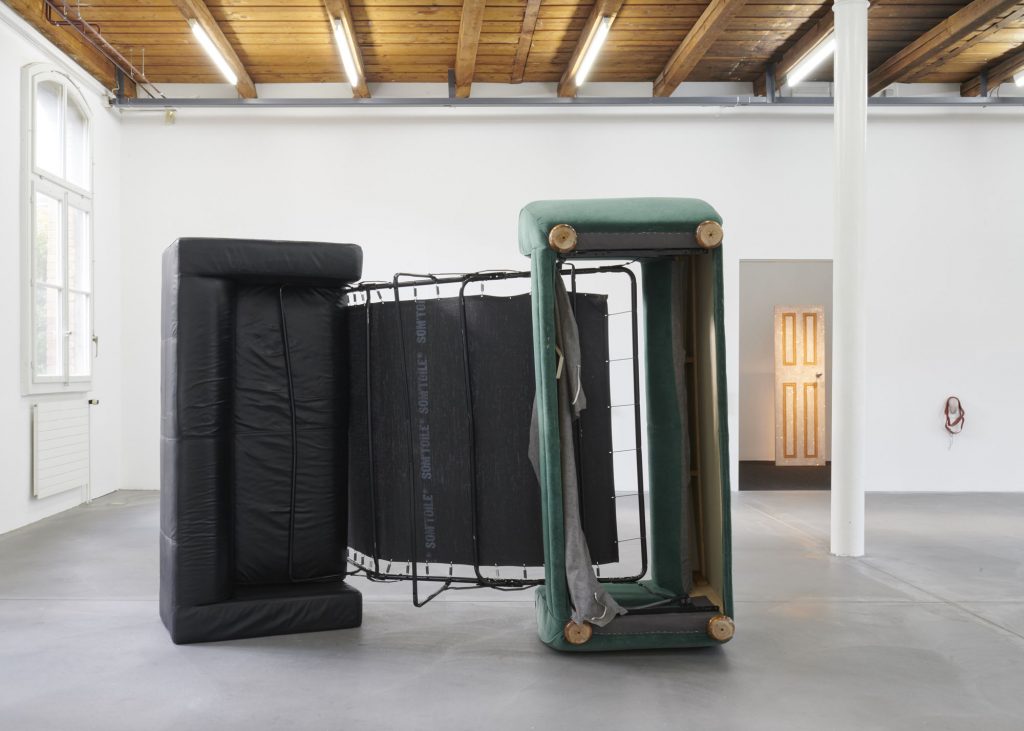
Information
The Fri Art story began in 1979 with the founding of a non-profit organisation by artist and curator Michel Ritter and a group of contemporary artists.
Two years later, the event Fri Art 81 made the walls of Fribourg's old diocesan seminary tremble and testified to the development of the contemporary art scene in this Zähringer city. Under the leadership of Michel Ritter, Fri Art created a multidisciplinary exhibition as part of the celebrations of the 500th anniversary of Fribourg's entry into the Confederation. Through exhibitions and performances Fri Art 81 brought together about sixty Swiss and international artists including Roman Signer, Anna Winteler and Container TV. The event gained international renown and was followed up with Fri-Art made in Switzerland, an exhibition organised on five different sites in New York and featuring more than 40 Swiss artists, including Meret Oppenheim, John Armleder, Christian Marclay, Dieter Roth and Roman Signer.
In 1982, Michel Ritter and the Fri Art association submitted a plan to the authorities for a permanent contemporary art centre. After several years of discussions and struggle and the support of many artists - including Jean Tinguely - the Fri Art Contemporary Art Centre, Fri Art, set up house on 10 November 1990 in a building made available by the town of Fribourg. This former cardboard factory (1896-1935) that also once served as a night shelter (1936-1990) meant that the Fribourg Kunsthalle was finally able to settle in a fixed location.
Finances remained uncertain however, as was the case for other cultural organisations in Fribourg, which came together from 1993 to 1997 as the Association Phare. This non-profit pooled the energies of these alternative venues, theatres, concert halls, art spaces and artists in protest against their insecure working conditions with the aim of encouraging politicians to define an ambitious, new cultural policy. The strength of this social and cultural movement led to the implementation of a new regional subsidy system.
Assisted by the photographer Eliane Laubscher, Michel Ritter organised many exhibitions, performances and artistic events at Fri Art over a period of twelve years (1990-2002) featuring both the Swiss and international scenes. Most of the artists exhibited during this period are seen today as historic artistic figures. The entire Swiss art scene and an informed audience met regularly in Fribourg to discover the first solo exhibitions of David Hammons, Dominique Gonzales-Foerster, Renée Green, Shirin Neshat, Thomas Hirschhorn, Christian Marclay, Jimmie Durham, Bernd & Hilla Becher, Julia Scher, Mark Dion, Valentin Carron, Steven Parrino and Wang Du among others. Architecture was also featured, with exhibitions presenting Herzog and de Meuron, Shigeru Ban, The Rural Studio and the Fribourg modernist Jean Pythoud. A great discoverer of talent, Michel Ritter turned Fri Art into a 'laboratory', enabling artists to experiment, question and make concrete their investigations. From its beginnings, the venue provided a focal point for Fribourg artists to gather and exchange views, offering a solid platform for the development of local artistic production. Michel Ritter was awarded the Merit Award for Art Mediators by the Federal Office of Culture (OFC) in 1995, the Frankfurt Art Award in 2004 and the Meret Oppenheim Award a year later.
In October 2002, Ritter became director of the Swiss Cultural Centre in Paris, and art historian Sarah Zürcher was appointed as his successor at Fri Art. She proposed a programme built around group exhibitions showing works by Swiss and international artists such as Armin Linke, Anselm Franke, Anne-Veronica Janssens, Carsten Nicolai, Thomas Schütte, Jane and Louise Wilson, Roman Ondàk, Zilla Leutenegger, Pierre Vadi, Frédéric Post, Isabelle Krieg, Nicolas Pages, Francis Baudevin and Karim Noureldin. French Curator Corinne Charpentier took over the reins at the Centre in 2007 and organised solo exhibitions by Amy O’Neill, Delphine Coindet, Peter Coffin, Stéphane Dafflon, Edith Dekyndt, Claudia Compte, João Maria Gusmão and Pedro Paiva, as well as Latifa Echakhch's first individual exhibition in Switzerland.
In 2013, the Fri Art association restructured its executive body and put a two-headed management system into place. Artistic direction was taken over by Balthazar Lovay in May 2013, while Julia Crottet became the administrative director. While Fri Art continues to serve as an artistic springboard with the first solo exhibitions of young Swiss and international artists such as Ramaya Tegegne, Cameron Rowland, Selina Grüter and Michèle Graf, Jason Loebs, Hanne Lippard and Lauris Paulus, it has also developed its identity as a venue for historical exhibitions and retrospectives (Film Implosion; A Retrospective of Closed Exhibitions; Kathe Burkhart, Peter Schuyff, Ferdinand Kriwet, Lucie Stahl). The programme has been enriched, for the first time, by an editorial policy accompanying certain projects such as The Anti Museum, Ramaya Tegegne, Peter Schuyff, Trix & Robert Haussmann and Robert Heinecken. Emphasis has also been placed on the organisation of events, especially performances and experimental music, as well as mediation projects.
In addition to exhibitions and events, the Kunsthalle is actively involved in the network of local cultural institutions (Association of Museums of the Canton of Fribourg, Association K) and participates in collaborations with WallRiss, FIFF and Nouvel Opéra de Fribourg, Bad Bonn and the Culture Department of the Town and Canton of Fribourg.
In almost forty years of existence, including thirty at the Rue des Petites-Rames, Fri Art has presented about 200 artists and more than 300 exhibitions to the public.
Closed
-
Monday
By appointment only
-
Tuesday
By appointment only
-
Wednesday
12:00 pm - 6:00 pm
-
Thursday
12:00 pm - 6:00 pm
-
Friday
12:00 pm - 6:00 pm
-
Saturday
1:00 pm - 6:00 pm
-
Sunday
1:00 pm - 6:00 pm
January 2, 2026 4:48 am local time
Location
-
Petites-Rames 22, 1700 Fribourg, Switzerland








Add a review